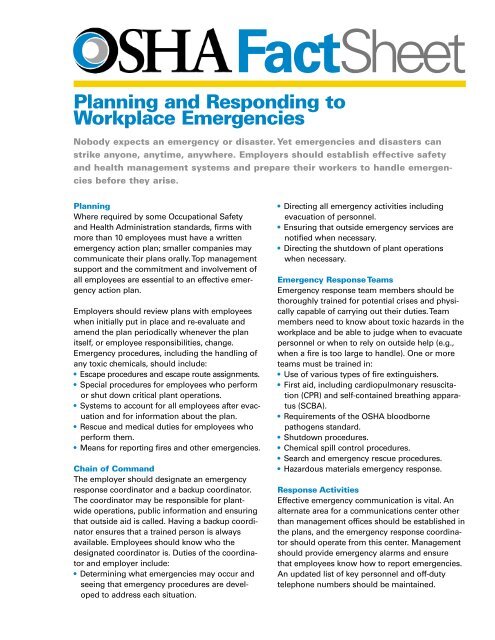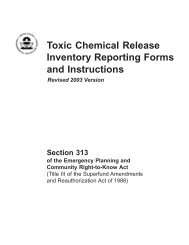OSHA FACTSHEET WORKPLACE EMERG - Seton Resource Center
OSHA FACTSHEET WORKPLACE EMERG - Seton Resource Center
OSHA FACTSHEET WORKPLACE EMERG - Seton Resource Center
Create successful ePaper yourself
Turn your PDF publications into a flip-book with our unique Google optimized e-Paper software.
Planning and Responding to<br />
Workplace Emergencies<br />
FactSheet<br />
Nobody expects an emergency or disaster. Yet emergencies and disasters can<br />
strike anyone, anytime, anywhere. Employers should establish effective safety<br />
and health management systems and prepare their workers to handle emergencies<br />
before they arise.<br />
Planning<br />
Where required by some Occupational Safety<br />
and Health Administration standards, firms with<br />
more than 10 employees must have a written<br />
emergency action plan; smaller companies may<br />
communicate their plans orally. Top management<br />
support and the commitment and involvement of<br />
all employees are essential to an effective emergency<br />
action plan.<br />
Employers should review plans with employees<br />
when initially put in place and re-evaluate and<br />
amend the plan periodically whenever the plan<br />
itself, or employee responsibilities, change.<br />
Emergency procedures, including the handling of<br />
any toxic chemicals, should include:<br />
• Escape procedures and escape route assignments.<br />
• Special procedures for employees who perform<br />
or shut down critical plant operations.<br />
• Systems to account for all employees after evacuation<br />
and for information about the plan.<br />
• Rescue and medical duties for employees who<br />
perform them.<br />
• Means for reporting fires and other emergencies.<br />
Chain of Command<br />
The employer should designate an emergency<br />
response coordinator and a backup coordinator.<br />
The coordinator may be responsible for plantwide<br />
operations, public information and ensuring<br />
that outside aid is called. Having a backup coordinator<br />
ensures that a trained person is always<br />
available. Employees should know who the<br />
designated coordinator is. Duties of the coordinator<br />
and employer include:<br />
• Determining what emergencies may occur and<br />
seeing that emergency procedures are developed<br />
to address each situation.<br />
• Directing all emergency activities including<br />
evacuation of personnel.<br />
• Ensuring that outside emergency services are<br />
notified when necessary.<br />
• Directing the shutdown of plant operations<br />
when necessary.<br />
Emergency Response Teams<br />
Emergency response team members should be<br />
thoroughly trained for potential crises and physically<br />
capable of carrying out their duties. Team<br />
members need to know about toxic hazards in the<br />
workplace and be able to judge when to evacuate<br />
personnel or when to rely on outside help (e.g.,<br />
when a fire is too large to handle). One or more<br />
teams must be trained in:<br />
• Use of various types of fire extinguishers.<br />
• First aid, including cardiopulmonary resuscitation<br />
(CPR) and self-contained breathing apparatus<br />
(SCBA).<br />
• Requirements of the <strong>OSHA</strong> bloodborne<br />
pathogens standard.<br />
• Shutdown procedures.<br />
• Chemical spill control procedures.<br />
• Search and emergency rescue procedures.<br />
• Hazardous materials emergency response.<br />
Response Activities<br />
Effective emergency communication is vital. An<br />
alternate area for a communications center other<br />
than management offices should be established in<br />
the plans, and the emergency response coordinator<br />
should operate from this center. Management<br />
should provide emergency alarms and ensure<br />
that employees know how to report emergencies.<br />
An updated list of key personnel and off-duty<br />
telephone numbers should be maintained.
Accounting for personnel following evacuation is<br />
critical. A person in the control center should<br />
notify police or emergency response team members<br />
of persons believed missing.<br />
Effective security procedures can prevent unauthorized<br />
access and protect vital records and<br />
equipment. Duplicate records of essential<br />
accounting files, legal documents and lists of<br />
employee relatives – to be notified in case of<br />
emergency – can be kept at off-site locations.<br />
Training<br />
Every employee needs to know details of the<br />
emergency action plan, including evacuation<br />
plans, alarm systems, reporting procedures for<br />
personnel, shutdown procedures, and types of<br />
potential emergencies. Any special hazards, such<br />
as flammable materials, toxic chemicals, radioactive<br />
sources or water-reactive substances, should<br />
be discussed with employees. Drills should be<br />
held at random intervals, at least annually, and<br />
should include outside police and fire authorities.<br />
Training must be conducted at least annually and<br />
when employees are hired or when their job<br />
changes. Additional training is needed when new<br />
equipment, materials or processes are introduced,<br />
when the layout or design of the facility changes,<br />
when procedures have been updated or revised,<br />
or when exercises show that employee performance<br />
is inadequate.<br />
Personal Protection<br />
Employees exposed to or near accidental chemical<br />
splashes, falling objects, flying particles,<br />
unknown atmospheres with inadequate oxygen or<br />
toxic gases, fires, live electrical wiring, or similar<br />
emergencies need appropriate personal protective<br />
equipment.<br />
Medical Assistance<br />
First aid must be available within 3 to 4 minutes of<br />
an emergency. Worksites more than 3 to 4 minutes<br />
from an infirmary, clinic, or hospital should<br />
have at least one person on-site trained in first aid<br />
(available all shifts), have medical personnel readily<br />
available for advice and consultation, and develop<br />
written emergency medical procedures.<br />
It is essential that first aid supplies are available to<br />
the trained first aid providers, that emergency<br />
phone numbers are placed in conspicuous places<br />
near or on telephones, and prearranged ambulance<br />
services for any emergency are available. It<br />
may help to coordinate an emergency action plan<br />
with the outsider responders such as the fire<br />
department, hospital emergency room, EMS<br />
providers and local HAZMAT teams.<br />
Further Information<br />
More detailed information on workplace emergencies<br />
is provided in “How to Plan for Workplace<br />
Emergencies and Evacuations” (<strong>OSHA</strong> 3088) available<br />
free on <strong>OSHA</strong>’s website or from <strong>OSHA</strong><br />
Publications, Room N3101, 200 Constitution Ave.,<br />
N.W., Washington, D.C. 20210, telephone 1-800-<br />
321-<strong>OSHA</strong>, or local <strong>OSHA</strong> offices. Further information<br />
is also available in <strong>OSHA</strong>’s Evacuation Plans<br />
and Procedure eTool and Emergency<br />
Preparedness and Response webpage<br />
This is one in a series of informational fact sheets highlighting <strong>OSHA</strong> programs, policies or<br />
standards. It does not impose any new compliance requirements. For a comprehensive list of<br />
compliance requirements of <strong>OSHA</strong> standards or regulations, refer to Title 29 of the Code of Federal<br />
Regulations. This information will be made available to sensory impaired individuals upon request.<br />
The voice phone is (202) 693-1999; teletypewriter (TTY) number: (877) 889-5627.<br />
Think Safety!<br />
For more complete information:<br />
U.S. Department of Labor<br />
www.osha.gov<br />
(800) 321-<strong>OSHA</strong>
















